Activities to develop sitting
Ideas and advice for parents and carers
General information
- Sitting requires more balance, better control and increased strength of the tummy, hip and back muscles than lying.
- Sitting gives your child a different view of the world and means they can use their hands more to explore toys.
- Once your child can sit briefly on the floor, practising sitting on a bench helps to develop trunk muscles, balance and putting weight through their feet, which is important for standing.
- Some children will bottom shuffle, using their feet to pull themselves forwards in sitting. You do not need to stop them doing this, but still encourage practicing moving into a crawling position.
Sequence
Pull to sit
Pull to sit
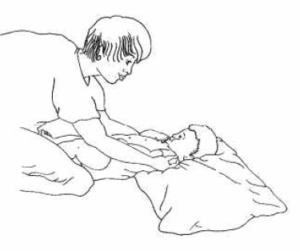
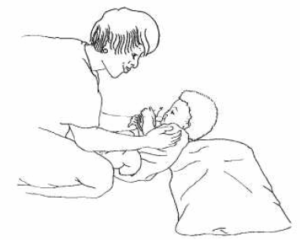
Position
- Lying on back (pillow initially)
- Support child’s shoulders and head with your hands
(as little support as needed) - Slowly bring child into sitting
- As child improves, move your hands to holding their upper arms, then holding their hands, then just one hand. See later activities for moving in and out of sitting
Encourage
- Head in middle
- Active tucking chin in and bracing shoulders
Play ideas
- Singing
- Funny faces
- Silly hat / head band
Sitting with support
Sitting with support
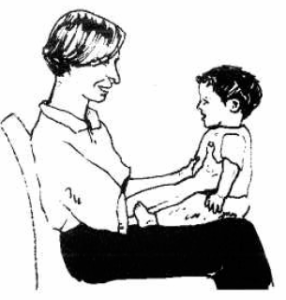
Position
- Sit child on a firm surface and hold around their middle trunk, facing away from you or towards you
- As child gains more control, reduce your support to be lower down the trunk then at the hips
Encourage
- Help child to prop with their hands on their thighs rather than the floor
- Bringing toys to mouth or to midline to bash
- Reaching for dangling toys
Play ideas
- Toys within reach in front of them
- Mirror
- Play gym (in sitting)
- Reaching for your face
Sitting independently
Sitting independently
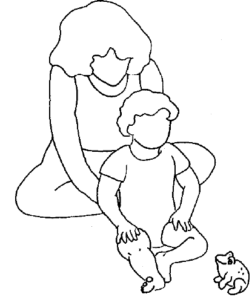
Position
- Start on firm surface, for example, floor
- Place cushions around child
- May prop on one hand first then lift both hands – may prop hands on floor or legs
- Initially back may be rounded
- Legs slightly bent at knees and not too far apart
Encourage
- Reaching for toys within reach, for example, in front of them, then to either side
- Sitting with straight back
Play ideas
- Songs “Row, row boat”, “Wind a bobbin”
- Naming / pointing to body parts
- Mirror
- Piano
- Rolling ball
- Try sitting child on a gym ball, gently bouncing and rolling them in all directions, encouraging them to stay upright
Sitting on a low chair / bench (box sitting)
Sitting on a low chair / bench (box sitting)
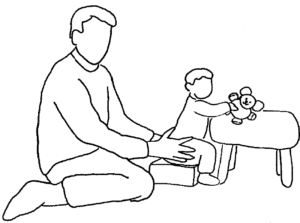
Position
- Sit on a little chair or bench with hips and knees at 90° angles, thighs are fully supported on bench and feet are flat on the floor
- Legs together
- Supervise closely as they may fall forwards
or back - Sofa or low table in front to play on
Encourage
- Sitting upright with straight back
- Turning to look over shoulder
- Reaching in all directions
- Sitting on chair with sides helps child prepare to push up to stand
Play ideas
- Bubbles
- Batting balloon
- Looking at books
- Singing
Side-sitting
Side-sitting
Side-sitting is important for developing control of turning the body. This is needed for crawling and walking.
Position
- Gently turn one leg so both knees pointing to the same side
- Propping on the hand on that side, help child reach in front and across
- Progress to both hands being down on the same side
Encourage
- Child starting to control own body and needing less support
- Reaching further for toys and up in the air
- Do little and often, frequently a difficult position
Play ideas
- Toys within reach in front and across body
- Rolling ball, toy car
Moving in and out of sitting
Moving in and out of sitting
Moving into sitting from lying
Instructions as for picture, repeat on opposite side
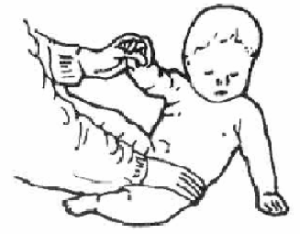
- Start with child lying on their back
- Hold their RIGHT hand, encouraging child to hold on to you as well as you to them
- Gently guide them up and over to LEFT to push up on LEFT hand. You can place one hand on their LEFT hip so that they don’t
roll over - Allow time for child to join in with the movement and to push on their other hand – give support slowly and as little as possible
- Encourage lifting their head and tucking chin in while pushing up on one hand
Moving out of sitting
- Into lying – sitting behind child, help them to go into side sitting then bend their elbow and lower to the floor
- Into crawling – help them go into side sitting then across into a crawling position (see crawling leaflet)
- Avoid letting child lower themselves forward between their legs and “doing the splits” to get on to their tummy, as this position stresses the hip joints


